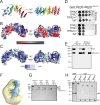The DEAD-box Protein Rok1 Orchestrates 40S and 60S Ribosome Assembly by Promoting the Release of Rrp5 from Pre-40S Ribosomes to Allow for 60S Maturation
- PMID: 27280440
- PMCID: PMC4900678
- DOI: 10.1371/journal.pbio.1002480
The DEAD-box Protein Rok1 Orchestrates 40S and 60S Ribosome Assembly by Promoting the Release of Rrp5 from Pre-40S Ribosomes to Allow for 60S Maturation
Abstract
DEAD-box proteins are ubiquitous regulators of RNA biology. While commonly dubbed "helicases," their activities also include duplex annealing, adenosine triphosphate (ATP)-dependent RNA binding, and RNA-protein complex remodeling. Rok1, an essential DEAD-box protein, and its cofactor Rrp5 are required for ribosome assembly. Here, we use in vivo and in vitro biochemical analyses to demonstrate that ATP-bound Rok1, but not adenosine diphosphate (ADP)-bound Rok1, stabilizes Rrp5 binding to 40S ribosomes. Interconversion between these two forms by ATP hydrolysis is required for release of Rrp5 from pre-40S ribosomes in vivo, thereby allowing Rrp5 to carry out its role in 60S subunit assembly. Furthermore, our data also strongly suggest that the previously described accumulation of snR30 upon Rok1 inactivation arises because Rrp5 release is blocked and implicate a previously undescribed interaction between Rrp5 and the DEAD-box protein Has1 in mediating snR30 accumulation when Rrp5 release from pre-40S subunits is blocked.
Conflict of interest statement
The authors have declared that no competing interests exist.
Figures







Similar articles
-
Rrp5 establishes a checkpoint for 60S assembly during 40S maturation.RNA. 2019 Sep;25(9):1164-1176. doi: 10.1261/rna.071225.119. Epub 2019 Jun 19. RNA. 2019. PMID: 31217256 Free PMC article.
-
Proofreading of pre-40S ribosome maturation by a translation initiation factor and 60S subunits.Nat Struct Mol Biol. 2012 Aug;19(8):744-53. doi: 10.1038/nsmb.2308. Epub 2012 Jul 1. Nat Struct Mol Biol. 2012. PMID: 22751017 Free PMC article.
-
The DEAD-Box Protein Rok1 Coordinates Ribosomal RNA Processing in Association with Rrp5 in Drosophila.Int J Mol Sci. 2022 May 19;23(10):5685. doi: 10.3390/ijms23105685. Int J Mol Sci. 2022. PMID: 35628496 Free PMC article.
-
Inside the 40S ribosome assembly machinery.Curr Opin Chem Biol. 2011 Oct;15(5):657-63. doi: 10.1016/j.cbpa.2011.07.023. Epub 2011 Aug 20. Curr Opin Chem Biol. 2011. PMID: 21862385 Free PMC article. Review.
-
Principles of 60S ribosomal subunit assembly emerging from recent studies in yeast.Biochem J. 2017 Jan 15;474(2):195-214. doi: 10.1042/BCJ20160516. Biochem J. 2017. PMID: 28062837 Free PMC article. Review.
Cited by
-
Pol5 is required for recycling of small subunit biogenesis factors and for formation of the peptide exit tunnel of the large ribosomal subunit.Nucleic Acids Res. 2020 Jan 10;48(1):405-420. doi: 10.1093/nar/gkz1079. Nucleic Acids Res. 2020. PMID: 31745560 Free PMC article.
-
Ribosome biogenesis factors-from names to functions.EMBO J. 2023 Apr 3;42(7):e112699. doi: 10.15252/embj.2022112699. Epub 2023 Feb 10. EMBO J. 2023. PMID: 36762427 Free PMC article. Review.
-
Synergistic defects in pre-rRNA processing from mutations in the U3-specific protein Rrp9 and U3 snoRNA.Nucleic Acids Res. 2020 Apr 17;48(7):3848-3868. doi: 10.1093/nar/gkaa066. Nucleic Acids Res. 2020. PMID: 31996908 Free PMC article.
-
snR30/U17 Small Nucleolar Ribonucleoprotein: A Critical Player during Ribosome Biogenesis.Cells. 2020 Sep 29;9(10):2195. doi: 10.3390/cells9102195. Cells. 2020. PMID: 33003357 Free PMC article. Review.
-
Attacking a DEAD problem: The role of DEAD-box ATPases in ribosome assembly and beyond.Methods Enzymol. 2022;673:19-38. doi: 10.1016/bs.mie.2022.03.033. Epub 2022 Apr 9. Methods Enzymol. 2022. PMID: 35965007 Free PMC article.
References
-
- Osheim YN, French SL, Keck KM, Champion EA, Spasov K, Dragon F, et al. Pre-18S ribosomal RNA is structurally compacted into the SSU processome prior to being cleaved from nascent transcripts in Saccharomyces cerevisiae. Mol Cell. 2004;16(6):943–54. . - PubMed
-
- Arcus V. OB-fold domains: a snapshot of the evolution of sequence, structure and function. Curr Opin Struct Biol. 2002;12(6):794–801. Epub 2002/12/31. . - PubMed
MeSH terms
Substances
Grants and funding
LinkOut - more resources
Full Text Sources
Other Literature Sources
Molecular Biology Databases

